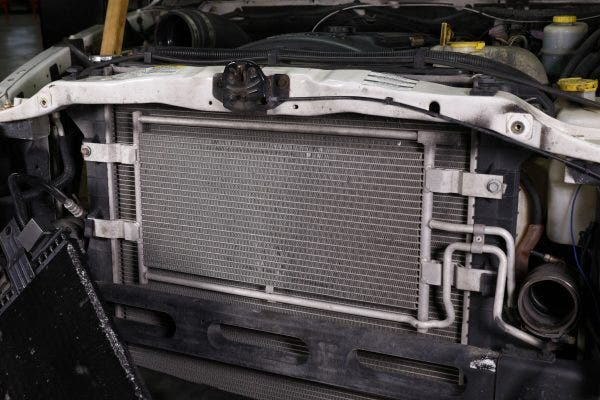
A Cooler for Atlas - Transmission Cooler R&D, Part 1: Stock Review
To be completely honest, I've never owned a truck. Apart from Dakar rally trucks, I prefer subtlety and agility over brute force and utility. I've also never owned a grizzly bear, but I still respect them. Without trucks, our economy would come to a halt, nothing would ever get built, and my subtle and agile car would be wasting away in the salty air of Baltimore's port, if it even made it that far.
It may not seem like it when you compare live axles and leaf springs to modern multi-link suspension systems and torque vectoring rear-diffs, but trucks are an impressive feat of engineering. They are capable of completing Herculean amounts of work, and must be robust enough to harness massive amounts of power, without disintegrating along the way. In the case of the 3rd generation Dodge Ram 2500 and 3500, the 5.9L or 6.7L Cummins engines provide up to 650 lb-ft of torque to tow or haul just about anything you could ever need.

This cutaway of an automatic heavy-duty truck transmission shows just how complex these machines are.
The truly impressive part of any powerful truck, however, is not just the engine, but the transmission attached to it. The transmission has the daunting task of taking that 600-plus lb-ft of torque produced by the engine and turning it into useable energy at the wheels. Like Atlas holding up the sky, the transmission is a silent servant that constantly bears the violent forces of the engine. For trucks outfitted with automatic transmissions, a maze of passages and valves guide fluid to operate clutches and planetary gear-sets, translating the engine's rotational force into forward motion. What's more impressive is that all that work is made possible by only about four gallons of transmission fluid.
As the transmission churns away, that fluid is squeezed onto clutch disks and crushed by gears. That violent action is necessary to deliver power from the engine to the wheels, but it also generates a dangerous by-product: heat. Automatic transmissions rely heavily on fluid pressure to work and, like an engine's oil, that fluid is designed to operate within a specific temperature range. Cold fluid doesn't flow easily, and makes it hard for pumps to move fluid where it needs to be. Hot fluid thins out and the transmission's pump cannot generate enough pressure to engage the clutch-packs. Even more detrimental, hot transmission fluid no longer provides a cushion for the gears' teeth, causing them to grind against each other instead of meshing seamlessly.

Here you can see the inlet and outlet port of an internal trans cooler, as well as some of the tube that makes up the cooler itself.
Luckily, most automatic vehicles incorporate a transmission cooler to keep the fluid within the optimal temperature range. Many small car and truck transmission coolers are a simple tube incorporated into the end-tank of the radiator. These coolers are cheap to make and great for light-duty use where the transmission won't get very hot. For larger trucks used for hauling and towing, an external cooler is a more effective solution. In the case of the Ram 2500 / 3500, the transmission is cooled by an external tube-and-fin heat exchanger, similar in design to the radiator it's mounted on.

The infamous 3rd Gen Cummins transmission cooler thermostat
The similarities between the engine radiator and the stock transmission cooler don't end there. Much like the flow through the radiator is controlled by the engine's thermostat, the transmission cooler also incorporates a thermostat. Housed in a small block at the upper-right portion of the transmission cooler, this thermostat diverts flow from the cooler until the fluid reaches the minimum specified operating temperature. The thermostat prevents the transmission from running with fluid that is too cold, but there's a hitch.

The housing for the transmission cooler thermostat on our truck was covered in grime and debris.
These aging thermostats have seen many thousands of gallons of transmission fluid in their long lives, and along with that, particulate and sludge from the daily toils of the transmission. Over time, this grime builds up on the thermostat and it fails to move with heat. When this happens, much, if not all the transmission fluid is blocked from reaching the cooler. A failed thermostat would be a pretty mild inconvenience if one could simply replace the thermostat, but that's not the case. Dodge does not sell the thermostat on its own, so a new transmission cooler is the only full fix. Some owners have gotten away with cleaning the thermostat, but unless you want to add draining the fluid and pulling apart your transmission cooler to your maintenance schedule , the problem is bound to come back.

Aside from stuck thermostats, the seemingly large transmission cooler fitted to the Ram 2500 and 3500 is still not enough for some drivers. For those who live in hot climates or tow heavy trailers up steep grades, transmission temperatures can reach uncomfortable levels quickly. The lack of airflow at lower towing speeds, combined with the constant load placed on the transmission, is a recipe for overheating. Without a bump in fluid volume, the stock transmission cooler just can't keep up.
Many Ram 2500 and 3500 transmissions have fallen victim to overheating due to thermostat failures and insufficient cooling, but we're working to save every transmission we can. Our engineer, Dan, is designing a transmission cooler for the third-gen Cummins Ram that will keep your truck cool and reliable for years to come. No more stuck thermostats or stopping on the side of a mountain to let the transmission cool.
Thanks for reading!
-Steve




